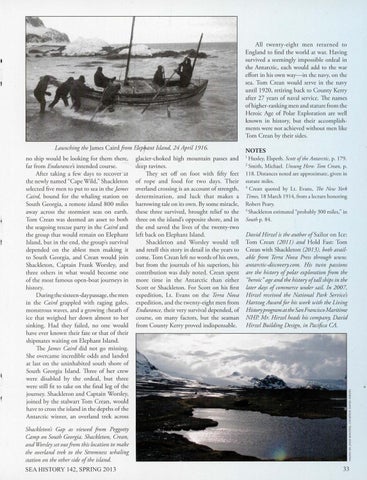All twenty-eight men returned to England to find the world at war. Having survived a seemingly impossible ordeal in the Antarctic, each would add to the war effort in his own way-in the navy, on the sea. Tom Crean would serve in the navy until 1920, retiring back to County Kerry after 27 years of naval service. The names of higher-ranking men and stature from the Heroic Age of Polar Exploration are well known in history, but their accomplishments were not achieved without men like Tom C rean by their sides. Launching the James Cairdftom Elephant Island, 24 April 1916.
no ship would be looking for them there, far from Endurance's intended course. After raking a few days to recover a.t the newly named "Cape Wild," Shackleton selected five men to put to sea in the fames Caird, bound for the whaling station on South Georgia, a remote island 800 miles away across the stormiest seas on earth. Tom Crean was deemed an asset ro both the seagoing rescue parry in the Caird and the group that would remain on Elephant Island, but in the end, the group's survival depended on the ablest men making it to South Georgia, and Crean would join Shackleton, Captain Frank Worsley, and three others in what would become one of the most famous open-boat journeys in history. During the sixreen-daypassage, the men in the Caird grappled with raging gales, monstrous waves, and a growing sheath of ice that weighed her down almost to her sinking. Had they failed, no one would have ever known their fate or that of their shipmates waiting on Elephant Island. The fames Caird did not go missing. She overcame incredible odds and landed at last on the uninhabited south shore of South Georgia Island. Three of her crew were disabled by the ordeal, but three were still fir to rake on the final leg of the journey. Shackleton and Captain Worsley, joined by the stalwart Tom Crean, would have to cross the island in the depths of the Antarctic winter, an overland trek across
glacier-choked high mountain passes and deep ravines. They set off on foot with fifty feet of rope and food for two days. Their overland crossing is an account of strength, determination, and luck that makes a harrowing tale on its own. By some miracle, these three survived, brought relief to the three on the island's opposite shore, and in the end saved the lives of the twenty-two left back on Elephant Island. Shackleton and Worsley would tell and retell this story in derail in the years to come. Tom Crean left no words of his own, but from the journals of his superiors, his contribution was duly noted. Crean spent more time in the Antarctic than either Scott or Shackleton. For Scott on his first expedition, Lt. Evans on the Terra Nova expedition, and the twenty-eight men from Endurance, their very survival depended, of course, on many factors, but the seaman from County Kerry proved indispensable.
NOTES 1
Huxley, Elspeth. Scott of the Antarctic, p. 179. Smith, Michael. Unsung Hero: Tom Crean, p. 118. Distances noted are approximate, given in statute miles. 3 Crean quoted by Lt. Evans, 7he New York Times, 18 March 1914, from a lecture honoring 2
Robert Peary. Shackleton estimated "probably 300 miles," in
4
South p. 84.
David Hirzel is the author ofSailor on Ice: Tom Crean (2011) and Hold Fast: Tom Crean with Shackleton (2013), both available .from Terra Nova Press through www. antarctic-discovery. com. His twin passions are the history ofpolar exploration .from the "heroic" age and the history oftall ships in the later days of commerce under sail. In 2007, Hirzel received the National Park Service's Hartzog Award for his work with the Living History program at the San Francisco Maritime NHP Mr. Hirzel heads his company, David Hirzel Building Design, in Pacifica CA.
Shackleton's Gap as viewed .from Peggotty Camp on South Georgia. Shackleton, Crean, and Worsley set out.from this location to make the overland trek to the Stromness whaling station on the other side ofthe island.
SEA HISTORY 142, SPRING 2013
33
